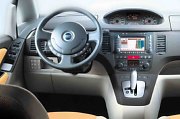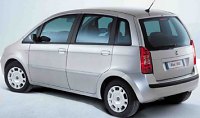|
 Idea
is the MPV version of Punto. Inevitably, its prime rival in Europe is
Opel
Meriva, which is similarly sized and priced. We know Meriva is strong
at
interior space and flexible seating plan, both are very important for a
mini MPV. Fiat Idea could not better it in these areas, but in the end
it is actually the better car here and even the most outstanding MPV
since
Fiat’s own Multipla and Renault Scenic II. So, what make it so
outstanding?
we shall see.... Idea
is the MPV version of Punto. Inevitably, its prime rival in Europe is
Opel
Meriva, which is similarly sized and priced. We know Meriva is strong
at
interior space and flexible seating plan, both are very important for a
mini MPV. Fiat Idea could not better it in these areas, but in the end
it is actually the better car here and even the most outstanding MPV
since
Fiat’s own Multipla and Renault Scenic II. So, what make it so
outstanding?
we shall see....
Externally,
the
Idea’s styling
looks cleaner, prettier and cultier than Punto II. This is because it
was
conceived by Giugiaro and finished by Fiat’s own Centro Stile while the
Punto II was completely the job of Centro Stile. Look back to history,
Fiat’s most successful cars in the modern era were all penned by
Giugiaro
- the Panda, Uno and the original Punto. Unluckily, Fiat switched back
to its own studio in recent years and resulted in the less convincing
Punto
II and Stilo. Both cars sold badly, which is hardly a coincidence. I
guess
Fiat’s management also saw this and therefore decided to seek help from
Giugiaro to do the Idea. The only bad styling in the Idea is the
conservative
grille and headlamps, which have a lot in common with the facelifted
Punto
II thus are undoubtedly the job of Centro Stile.
The MPV
version
is just 48mm
longer than Punto in wheelbase, but it is 180mm taller, a little wider
and a little longer. The high roof and high seating level (40mm above
Punto)
boost usable space a lot, enabling the accommodation of 4 six-footers
in
comfort. Best of all, the 60/40-split rear seats are mounted on rails
and
can be slide back and forth while their backrests can be adjusted for a
wide range of angles. As a result, passengers of different sizes won’t
have problem to find a comfortable sitting position. Besides, the cabin
is covered with big windows, feeling bright and airy.
 The
luggage compartment is not as big as Meriva, nor the rear seats fold as
cleverly. They don’t fold flat, but flip forward to release a loading
area,
whose volume is of course no match with Meriva. Nevertheless, the Fiat
MPV strikes back in visual quality. Its 2-tone styling is cool. Switch
gears and air vents have quality feel. Soft-touch plastics used in the
main dashboard and console is a first in this segment. Fit and finish
is
first class. In terms of quality, it is million miles better than
Meriva
and has nothing in common with Punto. How Fiat manage to package its
small
car so expensively is unknown. The
luggage compartment is not as big as Meriva, nor the rear seats fold as
cleverly. They don’t fold flat, but flip forward to release a loading
area,
whose volume is of course no match with Meriva. Nevertheless, the Fiat
MPV strikes back in visual quality. Its 2-tone styling is cool. Switch
gears and air vents have quality feel. Soft-touch plastics used in the
main dashboard and console is a first in this segment. Fit and finish
is
first class. In terms of quality, it is million miles better than
Meriva
and has nothing in common with Punto. How Fiat manage to package its
small
car so expensively is unknown.
The
Idea MPV also
drives
like a much more expensive car. Its 80hp 1.2-litre 16V and 95hp
1.4-litre
16V petrol engines, 70hp 1.3-litre Multijet and 100hp 1.9-litre
Multijet
turbo diesel engines are all refined and eager, if underpowered. The
Idea
is 200kg heavier than the similarly-engined Punto, thus performance is
inevitably unremarkable. However, it is undeniable that while AutoZine
always pick the most powerful engines, the market actually favours the
less powerful versions for their price and fuel consumption benefit.
Fiat
knows very well what the customers of small cars need, that’s why they
did not put a 1.8-litre petrol engine into the Idea, unlike Opel
Meriva.
What they need to make sure is to have the best small engines on the
market,
especially diesel. And it did that convincingly.
 Punto
was never renowned for driver appeal. The same goes for its MPV
version.
However, by MPV standard the Idea is competent. Its electric power
steering
lacks feel but is light and pretty accurate. Its handling is good
enough,
thanks to a 20% stiffening of suspensions. Body roll and understeer are
well checked. Despite that, it still rides smoother than the Punto. The
longer wheelbase and higher load may be part of the reason. Punto
was never renowned for driver appeal. The same goes for its MPV
version.
However, by MPV standard the Idea is competent. Its electric power
steering
lacks feel but is light and pretty accurate. Its handling is good
enough,
thanks to a 20% stiffening of suspensions. Body roll and understeer are
well checked. Despite that, it still rides smoother than the Punto. The
longer wheelbase and higher load may be part of the reason.
In short, Idea
is
an all-rounder
with an especially desirable packaging. The only area it lost to Meriva
is luggage-carrying capability. However, mini MPVs are not supposed to
be trucks. The Idea overshadowed Meriva in most other areas, including
mechanical refinement and build quality, which should be a shock to its
German rival. If Meriva can sell 200,000 units a year according to
plan,
Fiat’s target of 130,000 units will seem to be too conservative.
|